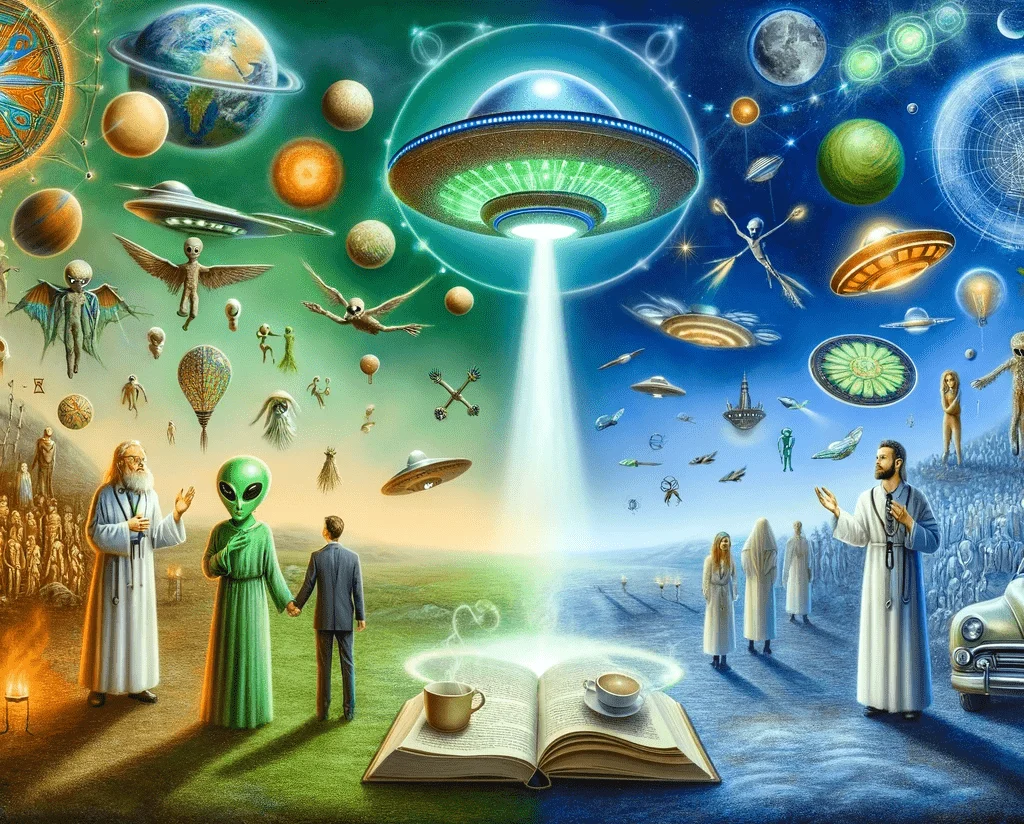Lights in the Sky & Little Green Men: A Rational Christian Look at UFOs and Extraterrestrials

“Lights in the Sky & Little Green Men: A Rational Christian Look at UFOs and Extraterrestrials” by Hugh Ross, Kenneth Samples, and Mark Clark seeks to address the topic of UFOs and the idea of extraterrestrial life from a distinct Christian and scientific perspective.
Hugh Ross, Kenneth Samples, and Mark Clark are notable figures associated with the organization “Reasons to Believe” (RTB), which stands as a bastion of Christian apologetics seeking to bridge the gap between scientific understanding and the Christian faith. Dr. Hugh Ross, an accomplished astrophysicist and Christian apologist, laid the foundation for RTB, drawing from his impressive educational background with a Ph.D. in astrophysics from the University of Toronto and research stints at the California Institute of Technology. His numerous books look into subjects encompassing the origins of the universe, intertwining scientific concepts with Christian theology to elucidate the divine hand in creation.
Kenneth Samples, a philosopher and theologian, has played a pivotal role within RTB as a senior research scholar. Armed with a fervent interest in Christian apologetics, theology, and the historical ideas, Samples uses his philosophical acumen to fortify the organization’s mission. He has composed a spectrum of literature that navigates the confluence of Christian faith, philosophy, theology, and science. His works champion reasoned defenses of Christianity, deftly addressing challenges from theological perspectives.
Mark Clark, while less prominently recognized in spheres beyond RTB, has collaborated notably with Ross and Samples on the publication “Lights in the Sky & Little Green Men.” His distinct contributions in this sphere pivot around a comprehensive exploration of UFO phenomena, looking into both scientific and Christian vantage points. While details about his specific background remain relatively elusive, Clark’s presence rounds out the triad of expertise, amalgamating the realms of astrophysics, philosophy, theology, and Christian apologetics.
Through their collective efforts in “Lights in the Sky & Little Green Men,” Ross, Samples, and Clark amalgamate their expertise to offer a distinctive perspective on the perplexing UFO phenomenon. Their collaboration encapsulates a synergy of astrophysical knowledge, philosophical insights, theological understanding, and Christian apologetics. This holistic approach not only reflects RTB’s overarching ethos of harmonizing science and faith but also underscores the multidisciplinary discourse required to address complex intersections between the natural world and matters of faith.
- Residual Phenomena:
- Only a small percentage of UFO sightings (about 1%, according to the authors) are classified as “residual phenomena,” which means they cannot be easily explained by natural or human-made events.
- Physical Explanations:
- The authors address a variety of physical explanations for these residual phenomena. They discuss the possibility of top-secret military projects, rare atmospheric conditions, and other terrestrial explanations.
- Extraterrestrial Hypothesis:
- The authors consider the hypothesis that some UFOs are spacecraft from extraterrestrial civilizations.
- While they don’t dismiss the possibility of extraterrestrial life entirely, they argue that the vast distances between stars make interstellar travel improbable. They also refer to the Fermi Paradox, the apparent contradiction between the high probability of extraterrestrial civilizations and humanity’s lack of contact with such civilizations.
- Interdimensional Hypothesis:
- The book also considers the idea that UFOs could be interdimensional rather than extraterrestrial.
- This theory posits that these beings or crafts could come from another dimension or reality.
- Spiritual Interpretation:
- Given the book’s Christian perspective, it dedicates considerable attention to a spiritual interpretation of the UFO phenomenon.
- The authors propose that if the phenomena are neither extraterrestrial nor explainable by natural means, they could be of a spiritual nature, either angelic or demonic.
- They further suggest that many characteristics of alien encounters align with descriptions of demonic activity in Judeo-Christian traditions.
- Abduction Experiences:
- The book addresses the accounts of those who claim to have been abducted by aliens. They discuss the common themes in these stories, such as the feeling of paralysis, out-of-body experiences, and the sensation of being watched.
- They relate these experiences to historical accounts of demonic activity and oppression.
- Scientific and Theological Integration:
- Throughout the book, the authors strive to combine scientific understanding with theological insights.
- They assert that the study of the universe and its phenomena can lead to a deeper understanding of God’s nature and creation.
There are numerous books on the subject of UFOs, extraterrestrial life, and the integration of science and theology.
“Lights in the Sky & Little Green Men” offers an intersectional perspective on the UFO phenomenon, weaving together scientific, theological, and spiritual explanations. The authors attempt to provide a comprehensive view that considers all possible explanations while rooting their perspective in Christian beliefs and understanding.


